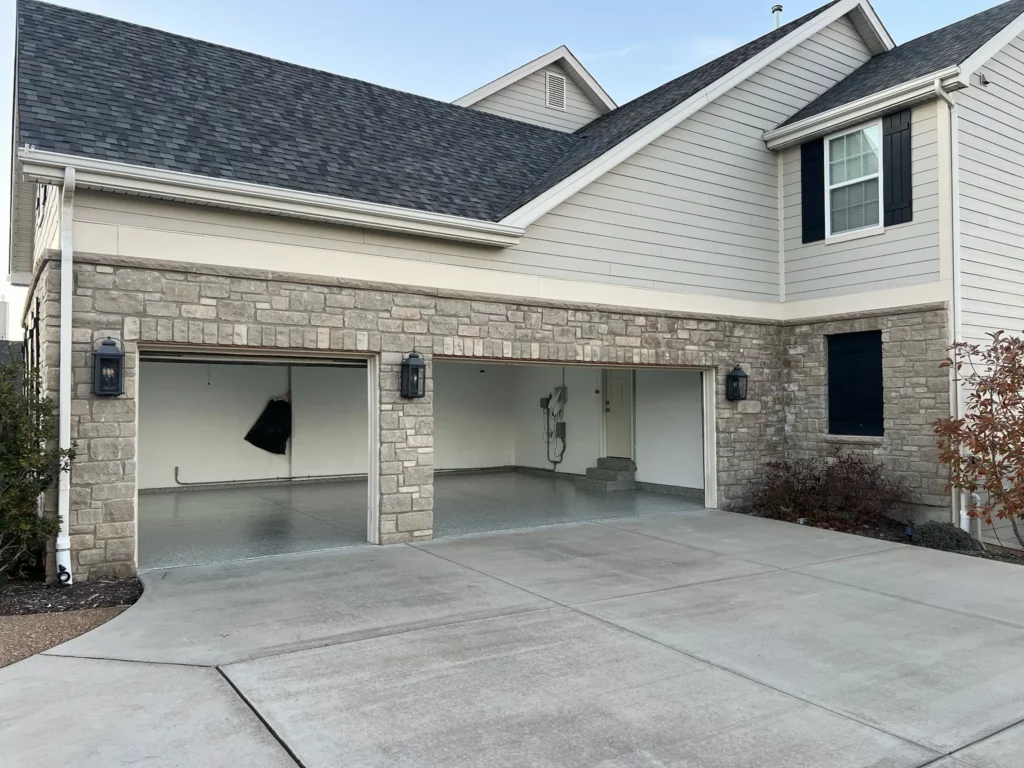If you’re thinking about upgrading your floors, you might be stuck between two popular options: epoxy vs. tile—so which lasts longer in Kirkwood, MO? With our wild weather swings, busy households, and heavy-foot-traffic businesses, durability matters. Both tile and epoxy can last a long time, but they offer very different paths to getting there.
The answer isn’t just about years on the clock—it’s about how each material handles moisture, wear, and real-world messes. And if you’re leaning toward epoxy, the pros at STL Coatings can help you make the most of it with expert prep and flawless application.
Let’s Talk Lifespan
Epoxy Flooring
- Professionally installed: 10–20 years or more
- DIY kits: 2–5 years
- Life can be extended with re-coating every 5–7 years
Tile Flooring
- Ceramic/Porcelain: 20–50 years
- Natural stone: Up to 100 years (with lots of maintenance)
- Grout lines can discolor or degrade over time
So, technically tile may last longer. But the real question is how each holds up—because a cracked tile or grimy grout line doesn’t feel like a win.

How They Handle Wear and Tear
Epoxy
- Resists cracks and chips (flexes slightly under pressure)
- Sealed surface keeps out moisture and stains
- Excellent for garages, basements, and high-traffic commercial spaces
Tile
- Very hard and dense, but brittle under impact
- Prone to chipping or cracking if heavy items drop
- Grout absorbs dirt, mold, and moisture unless sealed regularly
Verdict: Epoxy is more forgiving and easier to keep looking “like new,” especially in environments with a lot of daily abuse.
Moisture Resistance
Epoxy
- Completely waterproof when properly installed
- Great for basements, bathrooms, and garages in moisture-prone Kirkwood
Tile
- Tile itself is water-resistant, but grout lines are vulnerable unless sealed
- Flooding can ruin subfloors and cause tile to lift
Verdict: Epoxy wins in flood-prone or high-humidity areas (like those Missouri spring storms).
Cleaning and Maintenance
Epoxy
- Sweep, mop, and you’re done
- No grout lines to trap grime
- Resists chemicals, oil, salt, and other messes
Tile
- Mopping is easy, but grout needs constant attention
- May require deep scrubbing or resealing
Verdict: Epoxy is far less demanding and easier to maintain.
Repairing Damage
Epoxy
- Small chips or dull spots can be patched or recoated
- Full refresh often just requires a topcoat
Tile
- Cracked tile? Time to demo and replace
- Matching tile color/size can be a challenge years later
Verdict: Epoxy is easier—and more cost-effective—to refresh or repair.
Appearance and Style Options
Epoxy
- Flake, metallic, solid colors, and custom logos/designs
- Modern or industrial aesthetic
- Glossy or matte finishes
Tile
- Traditional patterns, wood-look planks, stone finishes
- Timeless appeal
- Limited color blending or full-floor customization
Verdict: Tile wins for traditional style; epoxy wins for bold, modern creativity.
Installation Process
Epoxy
- Requires surface grinding and moisture testing
- Coating and cure time: 2–4 days
- Odor can be strong during install (but dissipates quickly)
Tile
- Demolition, backer board, adhesive, grout, sealing
- Can take a week or more
- Labor-intensive, especially for patterned layouts
Verdict: Epoxy is faster to install and easier to update later.
Where It Matters Most in Kirkwood Homes
- Basements: Epoxy resists water, mold, and musty smells. It also doesn’t feel as cold underfoot.
- Garages: Epoxy beats tile hands-down for resisting tire marks, salt, and heavy tools.
- Kitchens and Bathrooms: Tile is more common but epoxy offers seamless, easy-clean surfaces with fewer slips and falls.
- Commercial Spaces: Epoxy wins for high traffic and ease of cleaning.
Consider Local Conditions
Kirkwood is charming and walkable—but it also brings plenty of rain, winter slush, and occasional humidity spikes. The floor you choose needs to resist all of that. And if you’ve ever taken the scenic route past the Frank Lloyd Wright House in Ebsworth Park, you know durability and thoughtful design can absolutely go hand in hand.
Like Wright’s work, epoxy isn’t just about what it does—it’s about how seamlessly it fits the space.

Cost Comparison
| Material | Upfront Cost | Long-Term Cost | Maintenance |
|---|---|---|---|
| Epoxy | $4–$10 per sq ft | Low (few repairs, occasional topcoat) | Very low |
| Tile | $5–$15 per sq ft | Moderate to high (grout sealing, tile replacement) | Moderate |
Tile may last longer overall—but epoxy offers more convenience and performance for the price.
Final Thoughts
So, epoxy vs. tile—which lasts longer in Kirkwood, MO? Technically, tile might hold the crown for total years lived. But epoxy often wins where it counts:
- It resists wear more gracefully
- It handles Kirkwood’s moisture and temperature shifts better
- It’s easier to repair, refresh, and maintain
If long-term performance with less fuss sounds good to you, epoxy is worth serious consideration.
And when you’re ready to move forward, STL Coatings can help you design a floor that lasts, looks amazing, and stands up to whatever life (or Missouri weather) throws at it.
